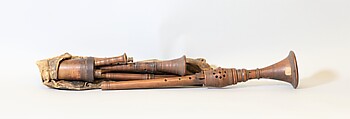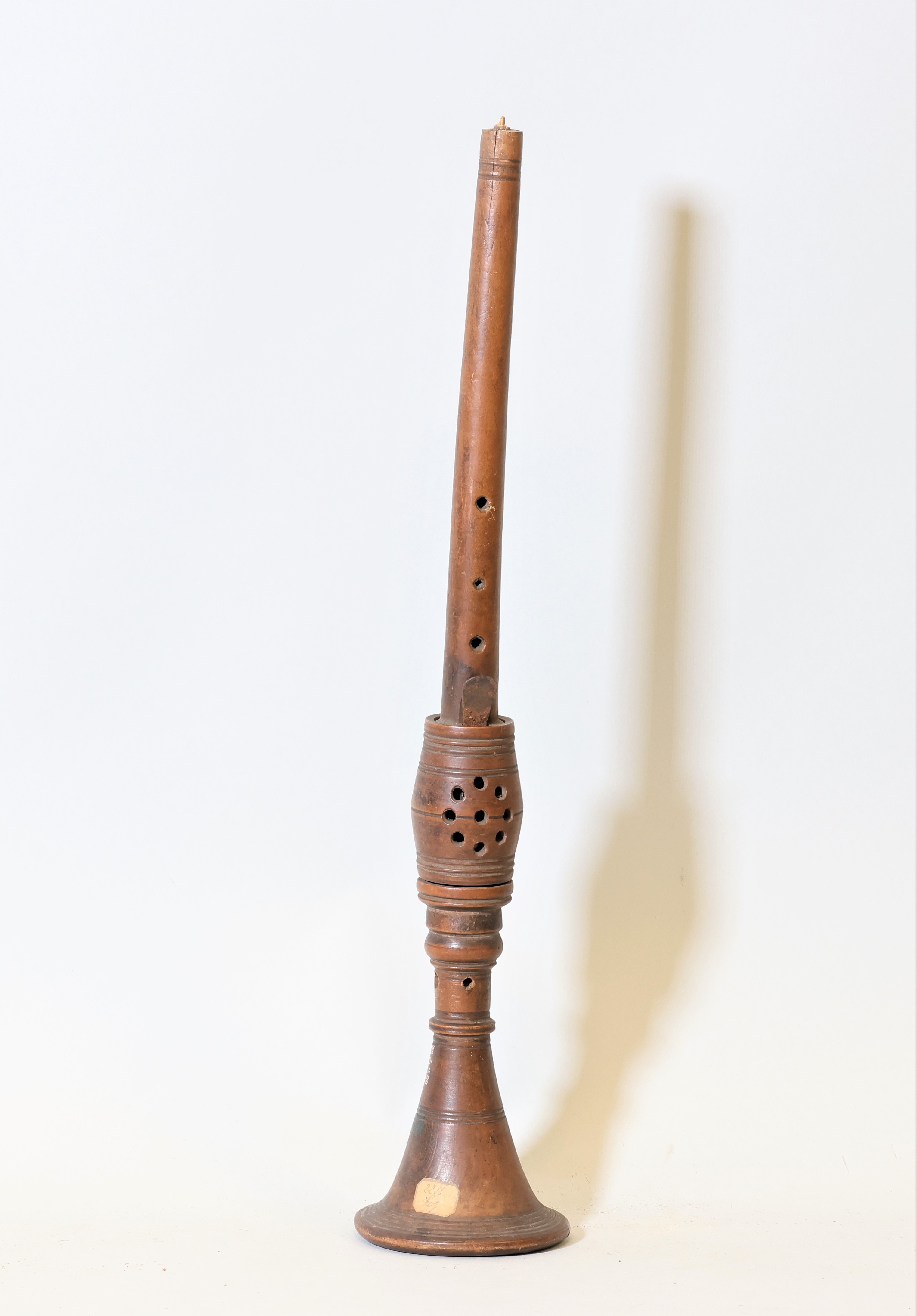Zampogna
19th century
Not on view
The zampogna is a bagpipe found in mountainous regions across Central and Southern Italy, including Sicily. It varies in size, tuning style, and local repertoire but always features two unequal divergent melodic pipes (Baines 1963:95) tuned in either octaves or thirds, and depending on region, anywhere from zero to three drones, most commonly having two drones playing octaves of the dominant (fifth) note of the scale. Melodic pipes are conical and drones consist of two cylindrical parts, the lower of which is wider than the higher section. The melodic pipes and drones are traditionally fitted with double reeds. The surdulina, found in northern Calabria and southern Basilicata, has a slightly different sent up with cylindrical bores and the use of single reeds. Each chanter is played by one hand, with the bass chanter creating a rhythmic/bass accompaniment to the more melodic fingering of the melody chanter. The name ‘zampogna’ most likely derives from the Latin ‘symphonia’ and became a standard name for the bagpipes in Italy from the 15th century onward (Vereno 2022:74).
This is a zampogna a chiave (keyed bagpipe) from the Molise/Abruzzo area. Its defining characteristics are the flared open bells at the end of each chanter, as well as sparse turning and a plain fuselage. However, the melody chanter and the small drone both have a closed bell and more wood-turning features and seem to borrow aesthetics from the more southern Lucanian style. The bass chanter and longer drone, however, are both clearly in the Scapolese style, which is associated with pipes from Abruzzo and Molise, where the main contemporary pipe making center is in the town of Scapoli, Molise. Interestingly, although the wood-turning aesthetics of the small drone are of the Lucanian style, it is a dummy drone, which fits into the Scapoli, Molise zampogna traditions, where zampognas only featured one functioning drone (the bass drone). The discrepancy between the drones and melodic pipes, suggests that this instrument could be composite with pieces made by two different makers, possibly as a restoration project, with newer parts made by a Lucanian maker, who followed the idiosyncracies of the Scapolian instrument, such as the dummy drone.
The head stock presents a crack, which was covered with red wax. The stock is also reinforced with a metallic brace, in order to prevent the crack from growing. These measures confirm that the original instrument was restored at least once.
The zampogna was traditionally played by shepherds and is still used for a variety of cultural practices, devotional and secular. In the Lucania region and parts of Calabria and the Abbruzzi they are often played in a duo formation with a ciaramella/piffero, a double reeded shawm. This duo has become emblematic of the Christmas season, where traditionally dressed pipers walk from village to village playing the ‘novena’, a form of devotional music (Scaldaferri 2022). Zampogna players have secular and religious repertoires. The former is used for the novena and devotional processions, while the latter are used to accompany dancing and singing.
(David Marker and Cassandre Balosso-Bardin, 2023)
Technical description
2 separate semi-melodic pipes of unequal length, made out of light wood with screw-on flaring bell, conical bores: r 320 mm, 5/1 holes, 2 ventholes; L 565 mm, 3/0 holes, 4 ventholes, 1 metal key covered with typical perforated barrel;
reeds missing (typically cane double reeds);
2 wooden drones aesthetically flared, but internally cylindrical bells, cylindrical bores – the top section has a narrower cylindrical bore than the lower section: 92 mm in 1 section, 337 mm in 2 sections, reeds missing (typically double cane reeds);
conical wooden blowpipe 120 mm;
dressed goatskin bag without cover;
cylindrical stock for blowpipe, large conical stock with 4 holes for sounding pipes, with metal reinforcing band;
all pipes and stocks with grooved turning.
References
Baines, Anthony, 1960. Bagpipes. Oxford: Oxford University Press.
Scaldaferri, Nicola, 2022. ‘The Bagpipes in the Mount Pollino Area (Southern Italy): Morphology and Musical Repertoires.’ In Playing Multipart Music: Solo and Ensemble Traditions in Europe: European Voices IV. Vienna: Böhlau Verlag. pp. 71-93.
Vereno, Michael Peter, 2021. The Voice of the Wind: A Linguistic History of Bagpipes. Lincoln: International Bagpipe Organisation.
Due to rights restrictions, this image cannot be enlarged, viewed at full screen, or downloaded.
This artwork is meant to be viewed from right to left. Scroll left to view more.




